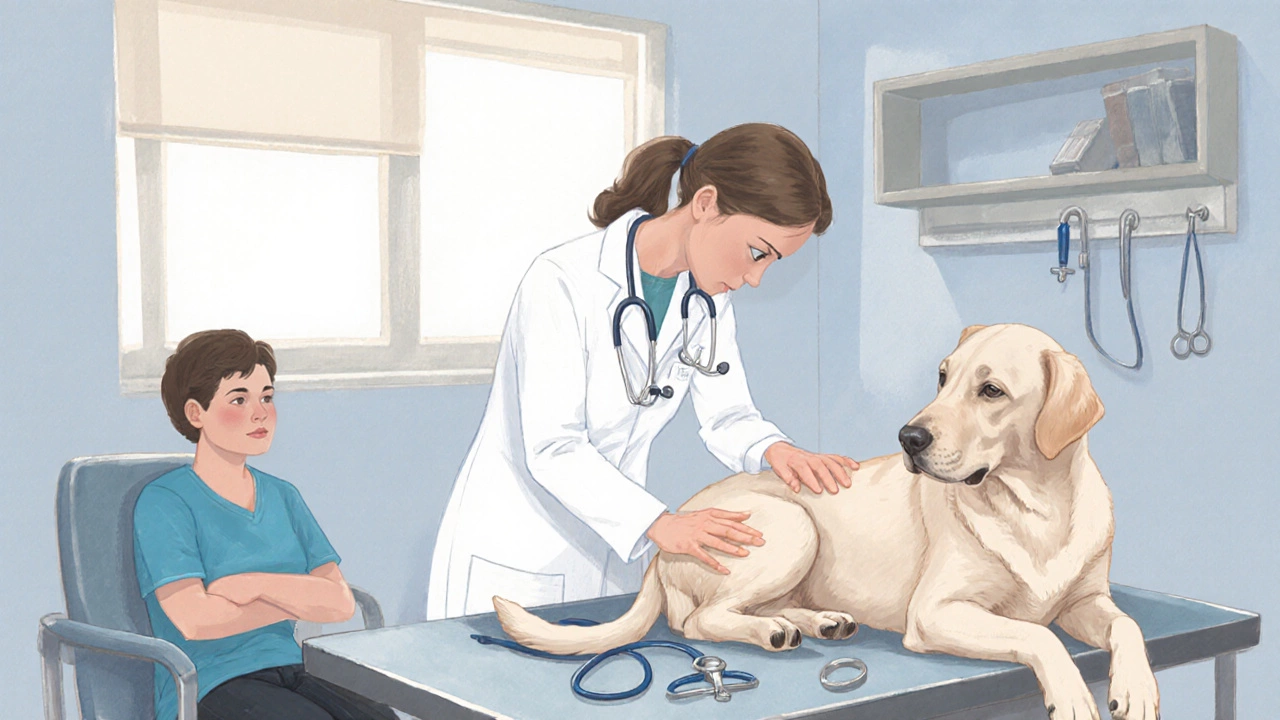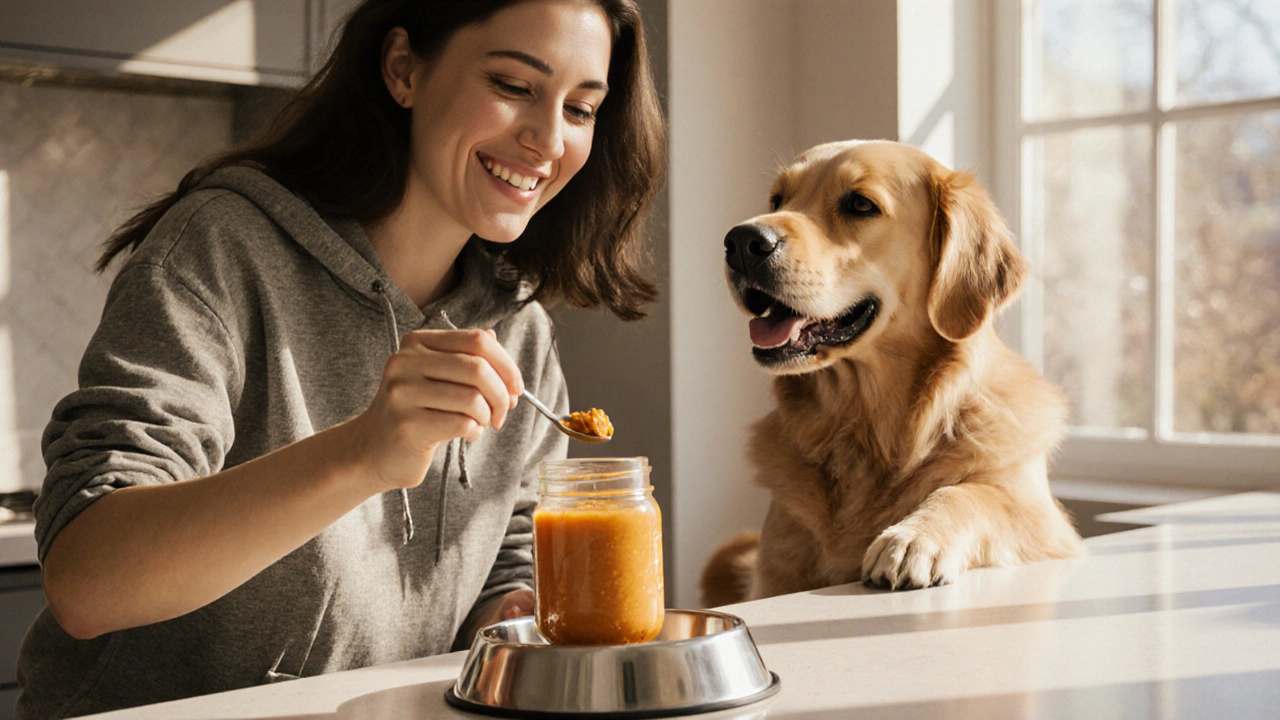Dog Pumpkin Dosage Calculator
Calculate Safe Pumpkin Amount
Enter your dog's weight and health conditions to determine the correct serving size of plain pumpkin.
Results
Note: Always use plain, unsweetened canned pumpkin. Do not use pumpkin pie filling or any spices.
Quick Takeaways
- Plain canned pumpkin is safe in small amounts for most dogs.
- Too much pumpkin can cause diarrhea, gas, or calcium loss.
- Dogs with pancreatitis, diabetes, or kidney disease need extra caution.
- Start with a teaspoon for a small dog, gradually increase to a tablespoon for larger breeds.
- If you notice vomiting, lethargy, or unusual stools, stop feeding pumpkin and call your vet.
Ever wondered why some dog owners swear by a spoonful of pumpkin while others warn against it? The truth sits somewhere in the middle. Pumpkin can be a handy source of fiber and vitamins, but too much of a good thing can turn into a gut‑upset or even a nutritional imbalance. This guide walks you through the most common side effects, who’s most vulnerable, and how to feed pumpkin safely.
Pumpkin for dogs is a dietary supplement made from plain, cooked pumpkin flesh, typically canned or pureed, that owners add to a dog’s meals for digestive or nutritional reasons. It’s not a magic cure‑all, but when used correctly it can smooth out occasional constipation, add a boost of beta‑carotene, and help regulate blood sugar. The key is understanding the pumpkin side effects dogs might experience if you overdo it.
What Exactly Is Pumpkin Doing in a Dog’s Body?
When you feed your canine a few spoonfuls of plain pumpkin, you’re primarily adding two things: soluble fiber and a modest dose of vitamins (mainly vitamin A, vitamin C, and potassium). The fiber acts like a sponge in the intestines, soaking up excess water and helping stool move through the colon more smoothly. Vitamin A supports vision and immune function, while potassium helps maintain proper muscle and nerve activity.
Fiber a type of carbohydrate that the body cannot digest, but that adds bulk to stool and feeds good gut bacteria is the star player here. Dogs that struggle with constipation often benefit from a modest fiber boost, and pumpkin is one of the gentlest sources.
Common Side Effects and What They Look Like
Most side effects show up when the dose is too high or when the pumpkin isn’t plain (spiced, sweetened, or mixed with other ingredients). Below is a quick reference table that outlines the typical symptoms you might see.
| Side Effect | Typical Symptoms | Severity |
|---|---|---|
| Diarrhea | Loose, watery stools; increased frequency | Moderate |
| Gas & Bloating | Stomach gurgling, flatulence, discomfort | Low to Moderate |
| Calcium Deficiency | Weakness, tremors, elevated heart rate | High (if chronic) |
| Hypervitaminosis A | Lethargy, bone pain, skin irritation | High (rare, only with massive over‑dosage) |
| Pancreatitis Trigger | Vomiting, abdominal pain, loss of appetite | High (in predisposed dogs) |
Most of these issues stem from feeding too much pumpkin too quickly. The gut bacteria need time to adjust, and an overload of soluble fiber can pull water into the intestines, leading to looser stools.

Who Should Be Extra Cautious?
While a healthy adult dog can usually tolerate a small daily serving, certain dogs are more vulnerable:
- Dogs with pancreatitis a painful inflammation of the pancreas that can be aggravated by fatty or high‑fiber foods - the extra fiber can increase pancreatic workload.
- Diabetic dogs canines whose bodies struggle to regulate blood glucose, potentially affected by pumpkin’s natural sugars - monitor blood sugar closely.
- Kidney‑diseased dogs pets with reduced kidney function that need careful potassium management - pumpkin is relatively high in potassium.
- Puppies and senior dogs - their digestive systems are more sensitive, so start with a very tiny amount.
Safe Dosage Guidelines
There’s no one‑size‑fits‑all number, but most veterinarians recommend the following as a starting point:
- Small dogs (under 20lb): ½teaspoon of plain canned pumpkin mixed into food once a day.
- Medium dogs (20‑50lb): 1teaspoon per day.
- Large dogs (over 50lb): 1-2tablespoons per day.
Always use pure pumpkin-no pumpkin pie filling, spices, sugar, or artificial sweeteners. If you’re feeding a commercial pumpkin supplement, follow the manufacturer’s label, but keep the total fiber from all sources under 5% of the dog’s daily caloric intake.

How to Introduce Pumpkin Safely
Start slow. Mix a tiny amount into a meal and watch for any changes in stool or appetite over the next 24-48hours. If everything looks normal, you can gradually increase to the recommended serving. Consistency is key: give the same amount each day rather than large occasional “treats.”
For dogs that hate the taste or texture, you can blend pumpkin with a little low‑fat plain yogurt or mix it into wet food. Just keep the added ingredients vet‑approved.
When to Stop and Call the Vet
Even with the safest approach, you should keep an eye out for red flags. Stop feeding pumpkin immediately and contact your veterinarian if you notice:
- Persistent diarrhea lasting more than two days.
- Vomiting, especially if it’s accompanied by abdominal pain.
- Signs of dehydration (dry gums, lethargy, sunken eyes).
- Unexplained weight loss or gain.
- Any changes in behavior that suggest pain or discomfort.
Early intervention can prevent a mild upset from turning into a serious electrolyte imbalance or a flare‑up of an underlying condition.
Frequently Asked Questions
Can I give my dog pumpkin pie filling?
No. Pie fillings usually contain sugar, spices, and sometimes nuts, all of which can be harmful to dogs. Stick to plain, unsweetened pumpkin.
Is canned pumpkin the same as fresh pumpkin?
Canned pumpkin is cooked and pureed, making the fiber more accessible. Fresh pumpkin needs to be cooked and pureed first. Either works, but canned is more convenient.
How does pumpkin help with constipation?
The soluble fiber absorbs water in the colon, softening stool and promoting regular bowel movements.
Can pumpkin lower a dog’s blood sugar?
In moderate amounts, pumpkin’s low glycemic index can help stabilize blood glucose, but it’s not a substitute for medication in diabetic dogs.
What should I do if my dog shows signs of pancreatitis after eating pumpkin?
Stop all food for a few hours, provide fresh water, and call your vet right away. Pancreatitis can become life‑threatening quickly.
Bottom line: pumpkin can be a useful, low‑cost supplement for many dogs, but like any food, the dose matters. Keep servings small, watch for the signs listed above, and always talk to your veterinarian if your dog has pre‑existing health issues.
